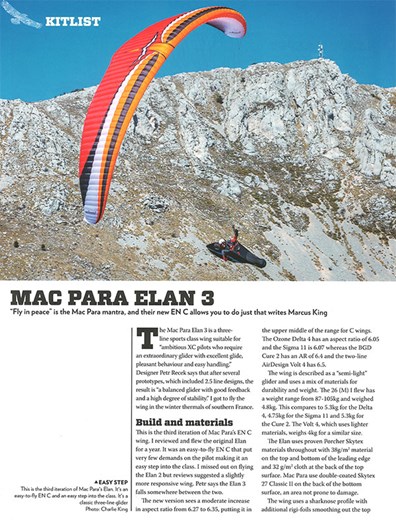“Fly in peace” is the Mac Para mantra, and their new EN C allows you to do just that writes Marcus King The Mac Para Elan 3 is a three-line sports class wing suitable for “ambitious XC pilots who require an extraordinary glider with excellent glide, pleasant behaviour and easy handling.” Designer Petr Recek says that after several prototypes, which included 2.5 line designs, the result is “a balanced glider with good feedback and a high degree of stability.” I got to fly the wing in the winter thermals of southern France.
Testpilot: Marcus King
Fotos: Charlie King
This is the third iteration of Mac Paras EN C wing. I reviewed and flew the original Elan for a year. It was an easy-to-fly EN C that put very few demands on the pilot making it an easy step into the class. I missed out on flying the Elan 2 but reviews suggested a slightly more responsive wing. Petr says the Elan 3 falls somewhere between the two.
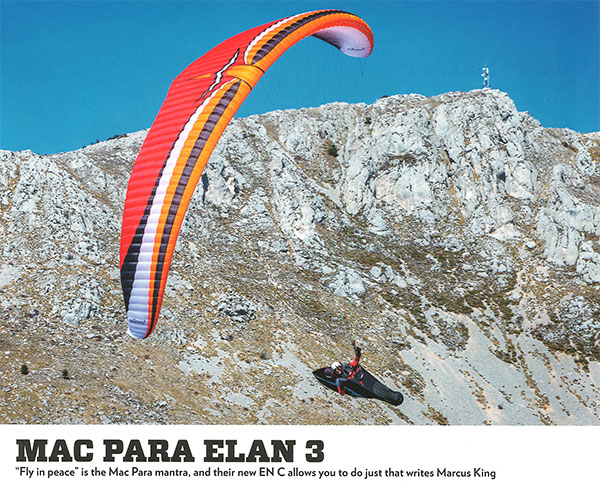
The new version sees a moderate increase in aspect ratio from 6.27 to 6.35, putting it in the upper middle of the range for C wings. The Ozone Delta 4 has an aspect ratio of 6.05 and the Sigma 11 is 6.07 whereas the BGD Cure 2 has an AR of 6.4 and the two-line AirDesign Volt 4 has 6.5.
The wing is described as a “semi-light” glider and uses a mix of materials for durability and weight. The 26 (M) I flew has a weight range from 87-105kg and weighed 4.8kg. This compares to 5.3kg for the Delta 4, 4.75kg for the Sigma 11 and 5.3kg for the Cure 2. The Volt 4, which uses lighter materials, weighs 4kg for a similar size.
The Elan uses proven Porcher Skytex materials throughout with 38g/m2 material on the top and bottom of the leading edge and 32 g/m2 cloth at the back of the top surface. Mac Para use double-coated Skytex 27 Classic II on the back of the bottom surface, an area not prone to damage.
The wing uses a sharknose profile with additional rigi-foils smoothing out the top surface, as we have seen on other wings from Mac Para. Small Mylar inserts are used to spread the load on these as well as to shape the sharknose. As on the Elan 7 there is negative shaping with a small panel above the cell openings. This is used to give a stronger nose without having to increase tension by pulling the tips out, which increases induced drag. As you would expect there are mini-ribs on the trailing edge. The overall look is clean. I noticed the wing-tip design has changed since the original Elan with an obvious up-turn.
Although Petr said they explored hybrid two/three-line structures they decided on a classic three-line set-up with bifurcation of the Cs to D tabs in the centre of the wing.
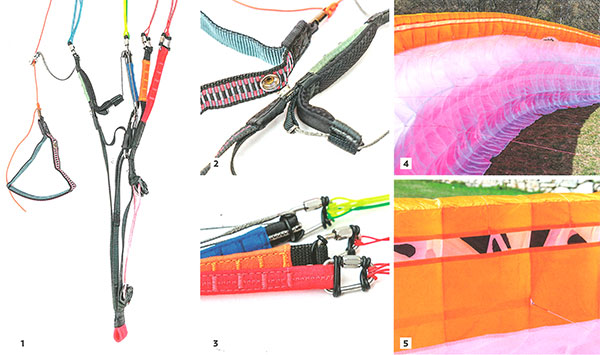
A plastic rod is sewn into the seam over the C and D attachments to spread the load over this section of the wing. The lines are a mix of sheathed PPSL lowers which are nicely colour-coded, and unsheathed Aramid uppers.
Lines are attached with maillons to 12mm risers. These come with a B/C-control system that uses a cord and low-friction rings to change the length of the risers when pulled. The advantage is that at trim the weight is fully on the risers. A padded area on the rear-riser is used for control and your hand sits there comfortably. Unusually these days, the brake handles are retained with poppers.
The wing is certified EN C in six sizes covering weights from 58kg to 145kg, making it one of the few choices for larger pilots. There are three standard colour choices with Mac Para offering a custom colour service.
Despite its relatively high aspect ratio the Elan 3 is easy to launch. A friend commented on the small cell openings but there is no delay in the wing filling and it rises steadily and easily in even the lightest breezes. It’s easy to correct the wing’s direction with extra pull on an A and once overhead it needs very little control, if any, to stop it.
In stronger winds the behaviour is similar and it comes up smoothly with no massive acceleration. Instead it is all very relaxed and should help you look like a pro. It definitely made things easier on a gusty launch on a thermic day.
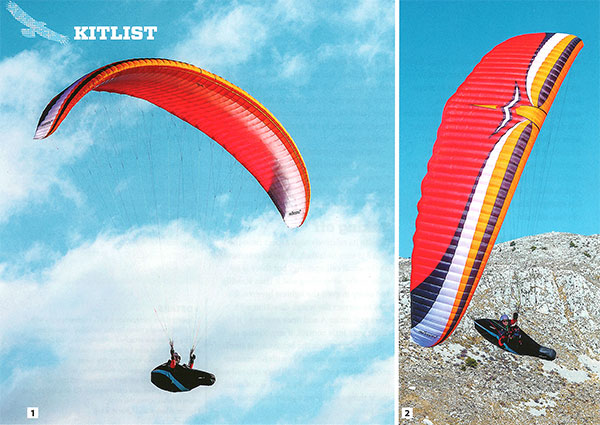
Over winter we saw a lot of northerly winds, meaning we have been flying in the protected lee-side bubbles on the sunny side. This has made for some bumpy conditions, mixing thermals and convergence.
I normally fly with a half-wrap and this feels perfect for the Elan 3. Brake pressure seems firm but not heavy and gives you a good connection to the wing. It is perhaps not the most agile, probably sitting in the middle, but the turn is very well balanced. I felt at home on the wing very quickly.
The glider likes to turn flat, but you can definitely crank it over when needed. On an inverted day I was able to work the tight cores well, giving it a kick of weight-shift to help it round. Going deep in the brakes you can take it to the stall point with no surprises. I like to find how far I can go with a wing, and pushing hard in a turn the pressure ramps up but not so that it gets hard; you can still get the wingtip to start to peel back. It is all very smooth and when released flies again quickly and without drama. Even when cranked over the wing doesn't dive in the turns, it still feels efficient.
Entering thermals the wing has a nice positive feel, it pulls you in. It’s a slow and relaxed feeling rather than an aggressive pitch, but you can feel the wing pulling into the lift nicely. This was especially noticeable working a series of bubbles coming off a small outcrop on a windy day. As I pushed forward into wind, I could feel the wing pulling forward and efficiently using the lift. With its flat turn this makes it nice and efficient in the weaker climbs, and I could keep up with all the wings on our local hill. It is undoubtedly a great climber that will help you make the most of the lift.
In stronger climbs there is no tendency for the wing to be pushed out. When you are turning in the thermal it generally needs very little management. There is a reasonable amount of information given. Even in feisty cores on a heavily inverted day, the wing's pitching was smooth so I could easily control it with a bit of outside brake. The wing moves as whole without bending or feeling fragile.
I really appreciated the style of pitch control of the Elan 3. Mac Para haven t made a wing that doesn’t seem to pitch at all, which I find can feel a bit confusing when you expect some degree of pitch. Instead they have made it pitch in a very smooth and controlled way that is easy to control with the brakes. Even flying along our local ridge in the mixing air, it was always easy to control the pitches and the wing pulled in the areas of lift well.
The wing seems to absorb turbulence well. I only had a couple of minor tip flaps despite flying in conditions that had pilots chatting about the “bumpiness” later. Pulling 50% side collapses shows a controlled response with a small turn and dive, but the smoothness of response makes it feel controllable.
The bar is fairly easy to use and not too heavy, so you wont be tired when pushing on it for long periods. Going full bar gives an increase over trim of around 14km/h. The wing feels stable even at full speed with no real need to control it. If you do, the B/C control system is effective if a bit heavy to pull.
Having my hands on the B/C system gave me good contact with the wing when on bar so I could feel the air. The system is efficient for steering along the better lines when on bar and I could use it to turn in larger areas of light lift. As always it is hard to give definitive performance figures, but the wing compared well with the mix of sports wings on our local sites. Its efficiency combined with relaxed feel meant I was able to push on.
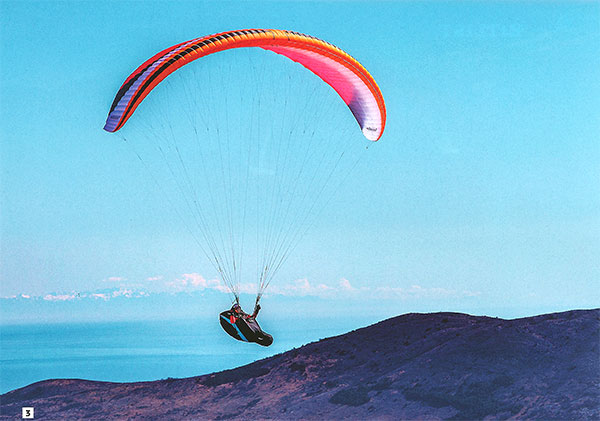
This is undoubtedly a cross-country machine but it doesn’t mean you can not have some fun. Wingovers are smooth and easy to get high on. Spirals are easy to control, and you can easily bleed the energy on exit so there will be no excessive pitching. Even when released more quickly the wings assured pitching behaviour makes things comfortable.
Big ears are easy to pull with the split A-risers. There is no flapping around and once settled they will stay in, rolling out slowly. A pump of the brakes will speed the reinflation up of course. Used with bar they give a good descent rate while allowing you to keep flying.
As you would expect, landings are all very easy on this wing. It is possible to slow it up nicely and I was able to top-land it in a tight area with no drama. The brakes work smoothly across the range making for an easy flare.
The Elan 3 continues Mac Paras mantra of “fly in peace”. It feels like a wing that is easy to fly within the category. Petr has managed to keep this ease of use and at the same time added the nice pitching behaviour that gives the wing a feel of power as it pushes into thermals and bubbles efficiently. On glide it has the ability to cut through the turbulence efficiently without being knocked back, giving it great performance in real air.
In short it makes for a great step into the C category for pilots looking to move up. Pilots moving down from higher level wings will find it engaging enough to keep them happy.
Marcus King
Marcus flew the Elan 3 26 (87-105kg) in the southern French Alps at around 101-103kg, paired with a Woody Valley GTO Light 2

